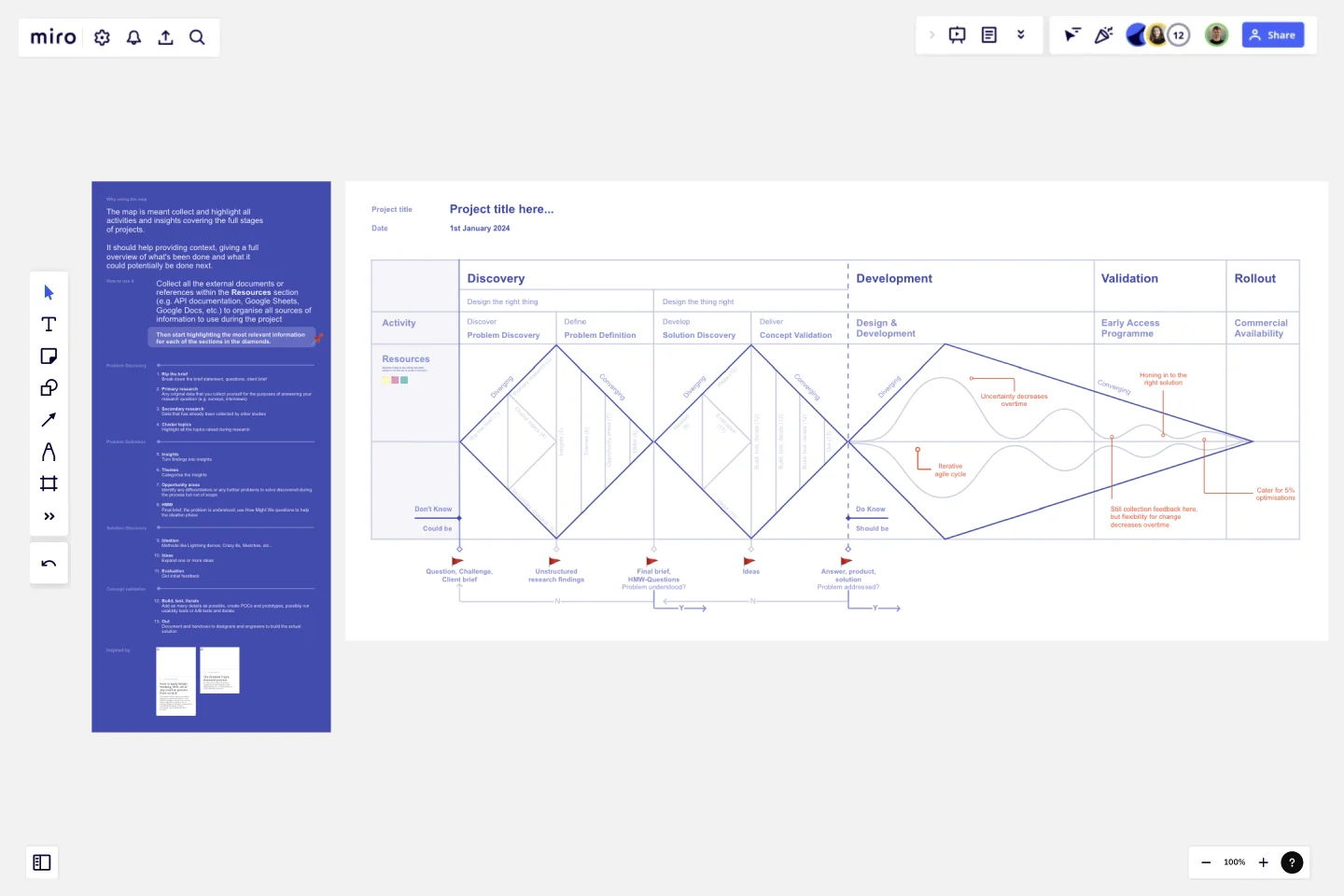[Triple Diamond] Project Map
In summary, the project map serves as a comprehensive tool for collecting, organising, and presenting information across all stages of project execution.
By providing context, highlighting past achievements, and delineating future actions, it facilitates informed decision-making, fosters collaboration, and promotes adaptive planning. As a dynamic and versatile resource, the map empowers stakeholders to navigate the complexities of project management with clarity and confidence. The purpose of the map is to comprehensively capture and illuminate all activities and insights that span across the entirety of the project stages. Its primary objective is to offer context and provide a holistic overview of past accomplishments while also delineating potential future actions.
The map serves as a repository for all project-related endeavors, encompassing initiation, planning, execution, monitoring, and closure phases. Consolidating information from each stage, it offers stakeholders a clear understanding of the project's progression and current standing.
One of the key functions of the map is to provide context. It achieves this by organizing data in a manner that illustrates the interconnectedness of various project components. Through visual representation, stakeholders can discern the relationships between different tasks, milestones, and outcomes. This contextualization facilitates informed decision-making and ensures alignment with overarching project objectives.
Moreover, the map offers a comprehensive overview of completed activities. By cataloging past accomplishments, it enables stakeholders to appreciate the journey thus far and recognise milestones achieved. This retrospective analysis not only instills a sense of progress but also provides valuable insights into the efficacy of previous approaches. Understanding what has already been accomplished serves as a foundation for devising future strategies and optimizing resource allocation.
In addition to showcasing past achievements, the map serves as a springboard for future endeavors. By delineating potential next steps, it empowers stakeholders to chart the course forward with clarity and purpose. Whether identifying areas for improvement, anticipating challenges, or exploring new opportunities, the map serves as a roadmap for informed decision-making. It not only guides strategic planning but also fosters innovation and proactive problem-solving.
Furthermore, the map facilitates effective communication and collaboration among project stakeholders. By offering a centralized platform for sharing information and insights, it promotes transparency and alignment of goals. Whether engaging with team members, clients, or external partners, stakeholders can leverage the map to convey progress, discuss strategies, and solicit feedback. This collaborative approach fosters a sense of ownership and collective responsibility, thereby enhancing overall project outcomes.
Another important aspect of the map is its adaptability. Recognising that projects are dynamic and subject to change, the map is designed to accommodate evolving circumstances and requirements. Through regular updates and revisions, it remains current and relevant, reflecting the latest developments and insights. This flexibility ensures that stakeholders are equipped with up-to-date information to make timely and informed decisions. Any feedback is appreciated if you use it for your projects!
This template was created by Stefano D'Avascio.
Get started with this template right now.
Agile Product Roadmap
Works best for:
Roadmap, Planning, Mapping
The Agile Product Roadmap template enables teams to visualize and communicate the strategic direction of their product development in an agile environment. It allows for flexibility and adaptation to changing requirements while providing a clear overview of priorities and timelines. By incorporating feedback loops and iterative planning, teams can ensure alignment with stakeholder expectations and deliver value incrementally.
Conversion Funnel Backlog Template
Works best for:
Decision Making, Product Management, Prioritization
If you’re working on a product that has clear conversions, then it can help to structure your backlog around the conversion funnel to make sure you’re reaching your audience. Creating a conversion funnel backlog brings together information around potential pain-points in your funnel and opportunities for growth. Once you’ve identified that information, it becomes easier to prioritize. You and your team can use the conversion funnel backlog to focus on conversion, retention, and referral, or to tweak your workflow in more mature products.
English Grammar Timeline Builder
The English Grammar Timeline template helps you map out the progression of grammar concepts over time. This is a great tool for educators and students to visualize the sequence and relationship between different grammar topics, making learning and teaching more effective.
Social Media Calendar Template
Works best for:
Project Planning, Marketing
Most businesses have a social media presence, but many of them aren’t using social media as a competitive differentiator. The Social Media Calendar template allows you to plan, schedule, and craft posts for LinkedIn, Twitter, Facebook, Instagram, and Pinterest, so you can leverage social media as a strategic tool to promote your brand. Use the Social Media Calendar template to plan out your social content a week, month, or quarter in advance. Collaborate with the marketing team, prepare for product launches and major initiatives, and share draft social posts.
Workday Calendar - Timeline 2024
Works best for:
Planning, Timeline
The Workday Calendar Timeline 2024 template is ideal for planning your work year. It helps you organize work schedules, track important deadlines, and plan for holidays and events. This template ensures you stay productive and on top of your work commitments.
Swimlane Diagram Template
Works best for:
Flowcharts, Diagrams, Workflows
A swimlane diagram shows you which stakeholders are responsible for each area of your critical processes. You can use it to understand current processes or plan new ones.
